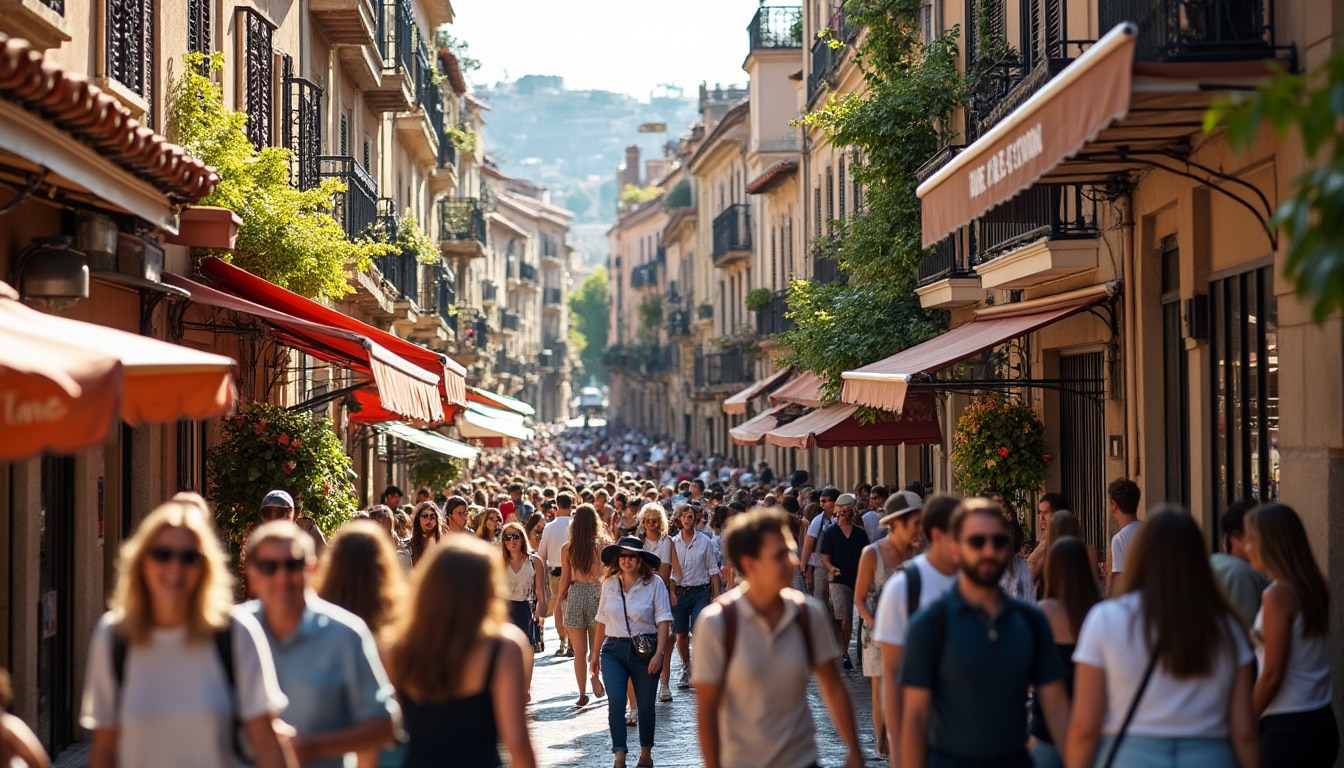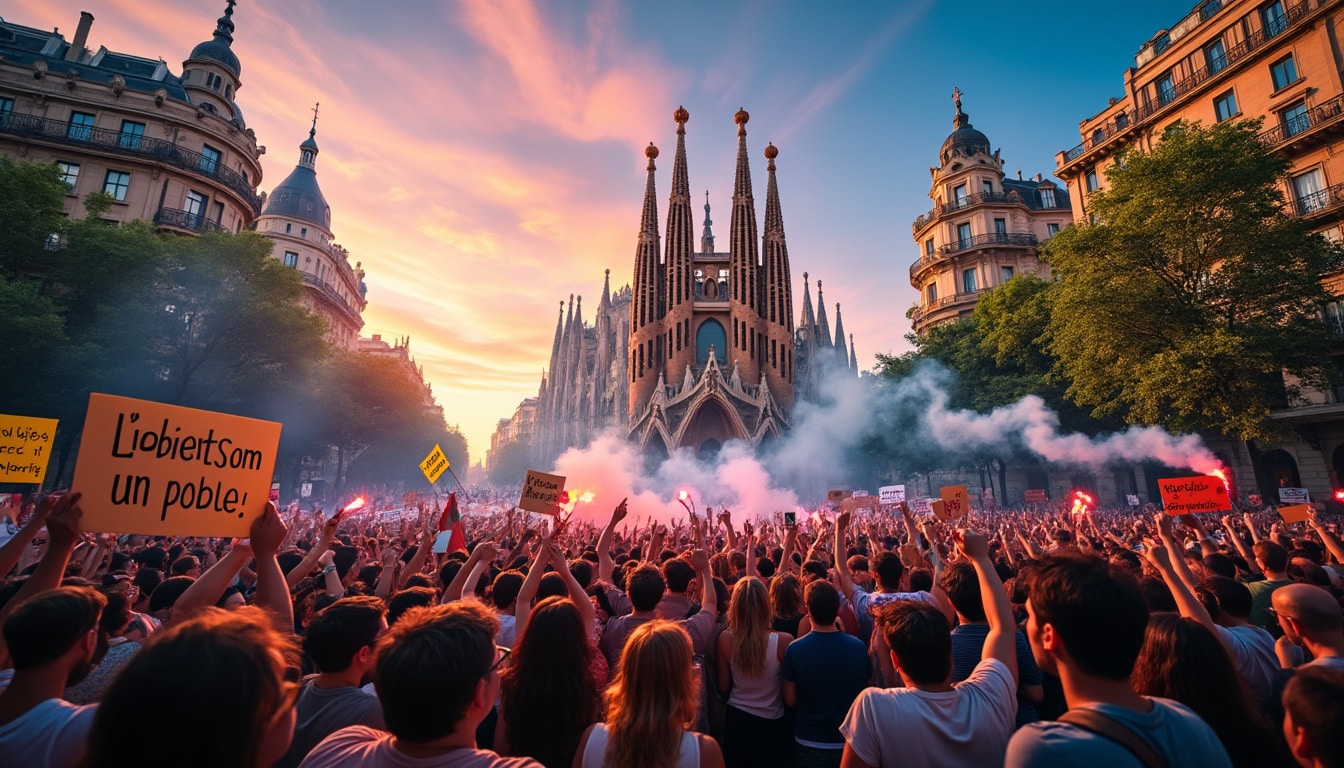Barcelona, an architectural jewel and cultural hub in Spain, has recently become a focal point for social unrest and protests. As the city waves goodbye to countless tourists every year, pressures mount on its local populace. From rising rents to the overwhelming presence of visitors, these issues have fueled a groundswell of demonstrations across the city. Various sectors of society, from local activists to governmental representatives, are all grappling with the complexities of these situations. Let’s dive deeper into the different facets of these protests, the actors involved, and the future of urban life in Barcelona amidst this turmoil.
The Impact of Mass Tourism on Barcelona’s Urban Landscape
Barcelona, known for its stunning architecture and vibrant cultural scene, has always attracted tourists in droves. However, the scale of tourism today is unprecedented. With more than 15.5 million visitors in 2024 alone, the city faces a dichotomy of economic growth against local dissatisfaction. The municipal government has taken multiple steps to mitigate the impact of what has come to be known as “overtourism.” Key measures include curbing new hotel constructions and maintaining a ban on Airbnb-style short-term rentals after 2028.

But why are locals so agitated? For one, this influx has driven up property prices and rents, pushing many long-time residents out of their neighborhoods. Distinct areas like the Gothic Quarter, once the heart of Barcelona’s culture and history, are now dominated by tourists rather than residents. The bustling La Boqueria market, popular since 1840, has similarly transformed into more of a tourist spot than a local shopping destination. This change has fueled anger amongst locals who feel disconnected from their own city’s identity.
There’s also the wear and tear on public infrastructure. Overcrowded public transport, increased pollution, and deteriorating walkways are byproducts of this overwhelming influx of visitors. While The North Face and Patagonia tourists scale the heights of Montjuïc, the quiet corners of the city witness the silent struggles of their inhabitants. More than just a strain on resources, locals perceive this as an eroding of their quality of life.
Response from Local Authorities and Activist Groups
Even though the local government is attempting to take action, many citizens feel these measures are insufficient. Protests have become a medium for citizens to voice their dissatisfaction, and not in an isolated fashion. These protests link up with other movements across Southern Europe, unifying under the banner of the Southern Europe Network Against Touristification. The objective is to collectively address the adverse effects of mass tourism.
Activist groups have orchestrated acts of protest in various forms. In one instance last year, activists fired water pistols at tourists in front of iconic sites like the Sagrada Família to symbolically ‘douse’ the issues. Such provocative yet peaceful demonstrations aim to provoke thought and gain global attention to this escalating crisis. The organizers argue that it’s not about harassment but about awareness. After all, a visit to Barcelona should not come at the cost of its inhabitants’ livelihoods.
- 📢 Organized walk-ins at tourist spots
- 🚫 Blockading tour buses
- 💦 Water pistol ‘squirt’ protests for media attention
| Year | Tourist Arrivals (millions) | Resident Protests (incidents) |
|---|---|---|
| 2023 | 15.6 | 10 |
| 2024 | 15.5 | 15 |
| 2025 | Expected increase | Expected increase |
Political Ramifications and Social Divisions
The protests in Barcelona are not just about tourism; they echo broader social and political issues. For example, Catalonia, the region Barcelona is a part of, has a fiercely independent spirit exacerbated by its historical push for independence. This backdrop adds another layer of complexity to current protests. Talks between the Spanish government and Catalan separatist parties have further fueled public unrest.
Authorities in Madrid recently faced protests over government negotiations with these separatist elements. Thousands protested against possible amnesty for individuals involved in past independence movements, amplifying criticism against the nation’s acting government, led by Pedro Sánchez. The arguments are twofold: should political appeasements compromise the nation’s adherence to law and justice? Consider the data:
| Location | Protest Type | Number of Protesters |
|---|---|---|
| Madrid | Anti-government | 7,000 |
| Barcelona | Pro-independence | Undisclosed |
| Canary Islands | Anti-tourism | 60,000 |
A significant portion of these protests is centered around the economic and social ramifications of Sánchez’s administration. Graffiti bearing brands like “Nike” and “Adidas” often scourge the cityscape during such protests, bringing to light issues relating to economic imperialism.
The Role of Brands in Protests and Social Unrest
In recent years, brands have become unlikely players in the arena of social protests, symbolizing the ever-growing consumer culture. During these protests, familiar symbols of consumerism, like Adidas or Nike, become representative of the socio-economic disparities fueling social unrest. While initially disconnected, these brands find themselves tangled in the narrative of the protests thanks to symbolic gestures and demonstrations.
Local stores from giants like H&M and Uniqlo have often become targets during demonstrations as symbols of foreign economic influence. For protests, they serve as an easy representation of the broader socio-political issues at stake. In an age where a tweet can shift public sentiment almost overnight, “going viral” is now a part of strategies devised by some activist groups, ensuring the message spreads globally.
- 💡 Adidas and Reebok – Symbols of consumer culture
- 🛒 H&M and Uniqlo – Targets of foreign influence
- 👟 Converse and Levi’s – Brands impacted by viral protests
Cultural Identity and Economic Resilience in Social Unrest
Barcelona’s social unrest is as much about cultural identity as it is about economics. Despite the challenges, the city demonstrates resilience. Efforts to preserve Catalan culture manifest in numerous ways, from attempts to regulate tourism to investments in local communities. This is deeply connected to the social fabric of Barcelona, committed to maintaining a distinct identity that’s neither overshadowed by tourism nor diluted by global consumer brands.
The city’s annual Festa Major de Gràcia, a vibrant cultural festival, is a poignant representation of this identity. Yet, even events like this face the challenges of commercialization, with tough decisions on how to balance tourism benefits with cultural authenticity. Such dilemmas cast a spotlight on ongoing tensions that are intersectional by nature, involving culture, economy, and political autonomy.
Puma and Converse shoes may traipse through the painted streets during the festival, even as Levi’s jeans make their mark on the urban tapestry. These brands’ integration into the cultural milieu illustrates a harmonious coexistence—a future where tourists appreciate rather than overshadow local identity.
- 🕺Preservation of Catalan culture
- 📅Investment in local events
- 🎨Regulating tourism to protect heritage
The Importance of Sustainable Tourism Practices
Tackling social unrest involves looking to sustainable tourism strategies that alleviate pressure on local communities. Public-private partnerships are emerging as viable options to navigate this landscape, fostering balance and dialogue between stakeholder interests. This collaboration can mend strained social fabrics and align global tourism trends with local wishes.
Barcelona’s forward-thinking measures, like imposing stricter regulations on accommodations and maintaining a ban on single-use plastics, reflect these sustainability goals. Furthermore, educational campaigns encouraging tourists to respect cultural norms offer tangible tools to surge ahead with this mission. The goal? Transform Barcelona into not just a tourist hotspot but a benchmark for urban livability.
Frequently Asked Questions
- Why are locals protesting against tourism in Barcelona?
- How are authorities responding to the protests in Barcelona?
- What role do brands have in these protests?
- How can tourism become more sustainable in Barcelona?

